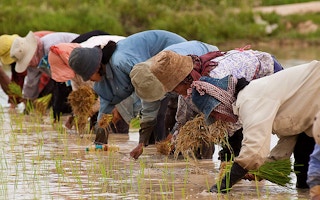Restaurateurs and entrepreneurs can now tap into Laos’ rich food and farming culture, with the launch of a website dedicated to preserving traditional recipes and agricultural practices before they die out.
The website highlights Laotian products like forest honey, and river weed that is pressed into sheets and dried to make a crispy snack, according to Michael Victor, who runs the Agro-Biodiversity Initiative, which helps fund the project.
Run by the agriculture and forestry ministry, the Pha Khao Lao Agrobiodiversity Resource Platformwas launched last week and will also include stories from farmers, as well information on traditional farming techniques.
“The platform is an attempt to find ways to strengthen local food systems in Laos, which are breaking down rapidly due to rise of industrial agriculture, commercialization and urbanization,” said Victor.
“The goal is to ensure that the rich natural heritage of Laos is conserved and used, and that knowledge is used by the new generation in a different way,” he said by phone from Vientianne, the Laotian capital.
The project also aims to spur agricultural and culinary entrepreneurship among young people and provide a resource to students and researchers, he added.
The government hopes the platform will help promote high-value, speciality agricultural products, said Manoluck Bounsihalath, director at the agriculture and forestry ministry, by phone.
Victor cited such products as teas and benzoin, which is extracted from tree bark and used in products including perfumes and incense, and as a food flavouring.
“
The goal is to ensure that the rich natural heritage of Laos is conserved and used, and that knowledge is used by the new generation in a different way.
Michael Victor, team leader, Agro-Biodiversity Initiative
He said that more than 200 tree and plant species - including rice - have been added to the platform already.
Laos has more types of rice than any other country except India, Victor added.
About 80 percent of Laos’ seven million people are farmers, growing crops including coffee, rubber and cassava, said food experts at the World Bank.
But only about 12 percent of farmland is irrigated, while a lack of infrastructure hinders production, processing and marketing, the World Bank experts said via email.
Most farms are less than 1 hectare - which is not large enough for commercial farming - with the majority of farmers still growing for subsistence, they said.
One of Asia’s poorest countries, Laos has struggled to compete with neighbouring commodity-producers like Thailand, Vietnam and China.
As well as giving recipes that use local products, those behind the website hope it will eventually link farmers with traders or consumers.
“It’s this whole movement about making connections between what we eat and where it’s produced - making people more aware of the importance of understanding where your food comes from,” he said.
This story was published with permission from Thomson Reuters Foundation, the charitable arm of Thomson Reuters, that covers humanitarian news, women’s rights, trafficking, property rights, climate change and resilience. Visit http://news.trust.org)










